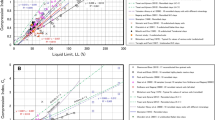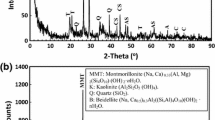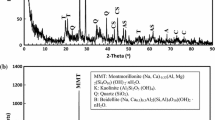Abstract
Due to complications in describing and analysing the behaviour of earth materials resulting from alteration of rocks, detailed laboratory and empirical studies of their geochemical, geological, and mechanical properties are very essential and require great attention. In this work, geochemical indices have been used as an important tool in characterising tropical clays and mechanical behaviour has been predicted using different techniques. This was achieved by using a scanning electron microscope equipped with an electron dispersive spectrometer and conducting statistical analysis on tropical clays, materials that are frequently encountered by practising engineers. The mechanical behaviour considered were inherent (in situ specific volume), compression (compression index and intercept), and strength (uniaxial compressive strength), and the indices used were physical (e.g. fines content), mineralogical (e.g. quartz), and chemical indices (e.g. silica-to-alumina ratio). Tropical clay can be characterised by relating chemical indices with both depth and in situ specific volume, and the most appropriate chemical indices are alumina-titania index (ATI), silica-titania index (STI), and silica-to-alumina ratio (SA). The in situ specific volume will be satisfactorily predicted by the coefficient of uniformity (Cu), ATI, STI, and SA. The fines content (Fc), Cu, quartz, and the SA are the most suitable predictor for the compression behaviour. The strength will be successfully predicted by Fc. Physical, mineralogical, and chemical indices can be used to predict mechanical behaviour, and they are recommended for practitioners working on these materials depending on the properties required.
Similar content being viewed by others
Abbreviations
- ATI:
-
Alumina-titania index
- Cc:
-
Compression index
- CF:
-
Clay fraction
- CIA:
-
Chemical index of alteration
- CIW:
-
Chemical index of weathering
- Cl:
-
Clay
- C u :
-
Coefficient of uniformity
- D 50 :
-
Mean particle size
- Fc:
-
Fines content
- Fe:
-
Feldspar
- Ip:
-
Plasticity index
- Lc:
-
Leaching coefficient
- LL:
-
Liquid limit
- N:
-
NCL intercept at 1 kPa
- PI:
-
Weathering product index
- PIA:
-
Plagioclase index of alteration
- PL:
-
Plastic limit
- Q:
-
Quartz
- Rc:
-
Residual coefficient
- SA:
-
Silica-to-alumina ratio
- STI:
-
Silica-titania index
- UCS:
-
Uniaxial compressive strength
- v :
-
In situ specific volume
- VRI:
-
Vogt’s residual index
- WIP:
-
Weathering index of Parker
References
Adams JS, Kraus MJ, Wing SL (2011) Evaluating the use of weathering indices for determining mean annual precipitation in the ancient stratigraphic record. Palaeogeogr Palaeoclimatol Palaeoecol 309:358–366
BSI (1990) Methods of test for soils for civil engineering purposes. British Standard Institution, London, UK.
Burland JB (1990) On the compressibility and shear strength of natural soils. Geotechnique 40:329–378. https://doi.org/10.1680/geot.1990.40.3.329
Chigira M (1990) A mechanism of chemical weathering of mudstone in a mountainous area. Eng Geol 29(119):138
Chigira M, Sone K (1991) Chemical weathering mechanisms and their effects on engineering properties of soft sandstone and conglomerate cemented by zeolite in a mountainous area. EngGeol 30:195–219
Chigira M, Oyama T (1999) Mechanisms and effect of weathering of sedimentary rocks. EngGeol 55:3–14
Chukwujike IC, Igwe IO (2016) Extender properties of some Nigerian clays. Journal of Minerals and Materials Characterization and Engineering 4:279–291. https://doi.org/10.4236/jmmce.2016.45025
Cotecchia F, Chandler RJ (2000) A general framework for the mechanical behaviour of clay. Geotechnique 50:431–447. https://doi.org/10.1680/geot.2000.50.4.431
Dah-TraoreY ZL, Seynou M, Ouedraogo R (2018) Mechanical, microstructural and mineralogical analyses of porous clay pots elaborated with rice husks. J Miner Mater Charact Eng 6:257–270. https://doi.org/10.4236/jmmce.2018.63019
de Jayawardena US, Izawa E (1994) A new Chemical Index of Weathering for metamorphic silicate rocks in tropical regions: a study from Sri Lanka. Eng Geol 36:303–310. https://doi.org/10.1016/0013-7952(94)90011-6
Delvaux B, Herbillon AJ, Vielvoye L (1989) Characterization of a weathering sequence of soils derived from volcanic ash in Cameroon. Taxonomic, mineralogical and agronomic implications. Geoderma 45:375–388
Duzgoren-Aydin NS, Aydin A, Malpas J (2002) Re-assessment of chemical weathering indices: case study of pyroclastic rocks of Hong Kong. Eng Geol 63:99–119. https://doi.org/10.1016/S0013-7952(01)00073-4
El Desoky H, Farouk S, Heikal M, El Mahallawy M, Wahid A (2019) Geochemical and technical investigation on some clay materials in the Bahariya Oasis, Western Desert, Egypt: implication in the vitrified clay pipes industry. J Afr Earth Sci 160:103612
El Desoky H, .Farouk S, Heikal M, El Mahallawy M, Wahid A (2020) Egyptian Cretaceous Clay Deposits: Insights on Mineralogy, Geochemistry and Industrial uses. Arab J Geosci 13(3):556
Folorunso DO, Aribo S, Olubambi PO, Borode JO (2012) Hydrometallurgical purification of some clay deposits for high temperature applications. JMMCE 5:461–469
Gupta AS, Rao KS (2000) Weathering effects on strength and deformational behaviour of crystalline rocks under uniaxial compression. Eng Geol 56:257–274
Gupta AS, Rao KS (2001) Weathering indices and their applicability for crystalline rocks. Bull Eng Geol Env 60:201–221
Harnois L (1988) The CIW index: a new Chemical Index of Weathering. Sed Geol 55:319–322
Harnois L, Moore JM (1988) Geochemistry and origin of the Ore Chimney Formation. A Transported Paleoregolith in the Grenville Province of Southeastern Ontario. Canada Chem Geo 69:267–289. https://doi.org/10.1016/0009-2541(88)90039-3
Heidari A, Raheb A (2020) Geochemical indices of soil development on basalt rocks in arid to sub-humid climosequence of Central Iran. J Mt Sci 17:1–18. https://doi.org/10.1007/s11629-019-5862-4
Heikal MThS, Khedr Mohamed Z, Abd El Monsef M, Gomaa S (2019) Petrogenesis and geodynamic evolution of albite granite, Central Eastern Desert of Egypt: petrological and geochemical constraints. J. African Earth Sci 158:103518
Hill IG, Worden RH, Meighan IG (2000) Yttrium: the immobility mobility transition during basaltic weathering. Geology 28:923–926
Hodder APW, Hetherington JR (1991) A quantitative study of the weathering of greywacke. Eng Geol 31:353–368
Irfan TY (1996) Mineralogy, fabric properties and classification of weathered granite in Hong Kong. Q J Eng Geol 29:5–25. https://doi.org/10.1144/GSL.QJEGH.1996.029.P1.02
Irfan TY (1999) Characterisation of weathered volcanic rocks in Hong Kong. Q J Eng Geol 32:317–328. https://doi.org/10.1144/GSL.QJEG.1999.032.P4.03
Jock AS, Ayeni FA, Ahmed AS, Sullayman UA (2013) Evaluation of the refractory properties of Nigerian Ozanagogo clay deposit. Journal of Minerals and Materials Characterization and Engineering 1:321–325. https://doi.org/10.4236/jmmce.2013.16048
Li WD, Wang WB, Cheng ZF, Zhou HM (1995) Geochemistry of lateritization process and the possibility of forming lateritic type gold deposits in southern China. Geological Press (In Chinese with English abstract).
Momeni AA, Khanlari GR, Heidari M et al (2015) New engineering geological weathering classifications for granitoid rocks. Eng Geol 185:43–51
Nesbitt HW, Young GM (1982) Early Proterozoic climates and plate motions inferred from major element chemistry of lutites. Nature 299:715–717. https://doi.org/10.1038/299715a0
Ng CWW, Guan P, Shang YJ (2001) Weathering mechanisms and indices of the igneous rocks of Hong Kong. Q J Eng Geol Hydro 34:133–151. https://doi.org/10.1144/qjegh.34.2.133
Nordt LC, Driese SD (2010) New weathering index improves paleorainfall estimates from Vertisols. Geology 38:407–410
Okewale IA (2017) Geotechnical and geological characterisation of decomposed volcanic rocks from Hong Kong. PhD Dissertation, City University of Hong Kong
Okewale IA, Coop MR (2017) A study of the effects of weathering on soils derived from decomposed volcanic rocks. Eng Geol 222:53–71. https://doi.org/10.1016/j.enggeo.2017.03.014
Okewale IA, Coop MR (2018a) On the effects of weathering on the compression behaviour of decomposed volcanic rocks. TuniRock 2018, Hammamet, Tunisia, 85–90.
Okewale IA, Coop MR (2018b) Suitability of different approaches to analyze and predict the behavior of decomposed volcanic rocks. J Geotech Geoenviron Eng 144:1–14. https://doi.org/10.1061/(ASCE)GT.1943-5606.0001944
Okewale IA (2019a) Influence of fines on the compression behaviour of decomposed volcanic rocks. Int J GeoEng 10:1–17. https://doi.org/10.1186/s40703-019-0101-y
Okewale IA (2019b) Effects of weathering on the stiffness characteristics and the small strain behaviour of decomposed volcanic rocks. J GeoEng 14:97–107. https://doi.org/10.6310/jog.201906_14(2).5
Okewale IA (2019c) On the intrinsic behaviour of decomposed volcanic rocks. Bull Eng Geol Env 79:1311–1322. https://doi.org/10.1007/s10064-019-01643-7
Okewale IA (2020a) Applicability of chemical indices to characterize weathering degrees in decomposed volcanic rocks. CATENA 189:1–13. https://doi.org/10.1016/j.catena.2020.104475
Okewale IA (2020b) Compressibility and the effects of structure of tropical clay in incremental loading oedometer tests. Geotech Geol Eng 38:5355–5371. https://doi.org/10.1007/s10706-020-01369-4
Okewale IA, Coop MR (2020) A study of completely decomposed volcanic rocks with transitional mode of behaviour. Bull Eng Geol Env 79:4035–4050
Okewale IA, Grobler H (2020) A study of dynamic shear modulus and breakage of decomposed volcanic soils. J GeoEng 15:53–66
Okewale IA, Grobler H (2021a) Mechanics of compression in talc considering sample quality. Arab J Geosci 14(441):1–13. https://doi.org/10.1007/s12517-021-06836-7
Okewale IA, Grobler H (2021b) Inherent complexities in weathered rocks: a case of volcanic rocks. Rock Mechanics and Rock Engineering 1–22. https://doi.org/10.1007/s00603-021-02569-x
Okewale IA, Grobler H (2021c) Influence of fabric and mineralogy on the mechanics of dolomitic rocks. Int. J. Min. Geo-Eng. Accepted.
OlaOlorun O, Oyinloye A (2010) Geology and geotechnical appraisal of some clay deposits around Ijero-Ekiti Southwestern Nigeria: implication for industrial uses. Pak J Sci Ind Res 53(3):127–135
Price JR, Velbel MA (2003) Chemical weathering indices applied to weathering profiles developed on heterogeneous felsic metamorphic parent rocks. Chem Geol 202:397–416. https://doi.org/10.1016/j.chemgeo.2002.11.001
Rocchi I, Coop MR, Maccarini M (2017) The effects of weathering on the physical and mechanical properties of igneous and metamorphic saprolites. Eng Geol 231:56–67
Rocchi I, Okewale IA, Coop MR (2015) The behaviour of Hong Kong volcanic saprolites in one-dimensional compression. Volcanic rocks and soils. Balkema, Rotterdam, pp 281–287
Seynou M, Millogo Y, Zerbo L, Sanou I, Ganon F, Ouedraogo R, Kabore K (2016) Production and characterization of Pozzolan with raw clay from Burkina Faso. JMMCE 4:195–209. https://doi.org/10.4236/jmmce.2016.43018
Udagedara DT, Oguchi CT, Gunatilake JK (2016a) Combination of chemical indices and physical properties in the assessment of weathering grades of sillimanite-garnet gneiss in tropical environment. Bull Eng Geol Environ 76:145–157
Udagedara DT, Oguchi CT, Gunatilake JK (2016b) Evaluation of geomechanical and geochemical properties in weathered metamorphic rocks in tropical environment: a case study from Samanalawewa hydropower project, Sri Lanka. Geosci J 21:441–452
Yami AM, Umaru S (2007) Characterization of some Nigerian clays as refractory materials for furnace lining. Continental J Engineering Sciences 2:30–35
de Jayawardena US, Izawa E (1994) A new Chemical Index of Weathering for metamorphic silicate rocks in tropical regions: a study from Sri Lanka. Eng Geol 36:303-310.https://doi.org/10.1016/0013-7952(94)90011-6.
Okewale IA, Grobler H (2020b) The effects of structure of Nigeria clay in one dimensional compression. The 2020 World Congress on Advances in Civil, Environmental, & Materials Research (ACEM20) 25-28, August, 2020, GECE, Seoul, Korea, pp 1-10.
Okewale IA, Grobler H (2020c) Mechanics of compression behaviour in shale. The 2020 World Congress on Advances in Civil, Environmental, & Materials Research (ACEM20) 25-28, August, 2020, GECE, Seoul, Korea, pp 1-10.
Okewale IA, Grobler H (2021d) Influence of Fabrics on Compression Mechanics of Iron Tailings. The International Conference Series on Geotechnics, Civil Engineering and Structures (CIGOS 2021), Lecture Notes in Civil Engineering 203, Springer pp 1-8. https://doi.org/10.1007/978-981-16-7160-9_113.
Okewale IA, Grobler H (2021e) Investigations into Grading Characteristics of Tailings. The International Conference Series on Geotechnics, Civil Engineering and Structures (CIGOS 2021), Lecture Notes in Civil Engineering 203, Springer pp 1-7. https://doi.org/10.1007/978-981-16-7160-9_114.
Acknowledgements
The authors would like to thank the National Research Foundation (NRF) of South Africa for the award of fellowship which led to this paper. The authors would like to appreciate Mr Akerele C. for his assistance in the laboratory in the course of conducting this research. Special thanks to Prof. Mohamed Th. S. Heikal, Prof. of Mineralogy and Petrology, Tanta University, Egypt, for his critical comments and suggestions that strongly improved the present article.
Author information
Authors and Affiliations
Corresponding author
Ethics declarations
Conflict of interest
The authors declare that they have no competing interests.
Additional information
Responsible Editor: Domenico M. Doronzo
Rights and permissions
About this article
Cite this article
Okewale, I.A., Grobler, H. Geochemistry and predictability of tropical clay behaviour using different techniques. Arab J Geosci 14, 2209 (2021). https://doi.org/10.1007/s12517-021-08596-w
Received:
Accepted:
Published:
DOI: https://doi.org/10.1007/s12517-021-08596-w















